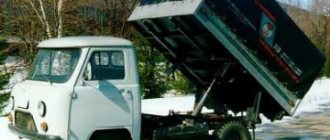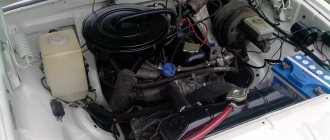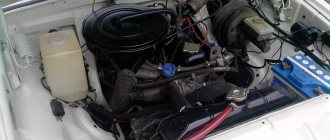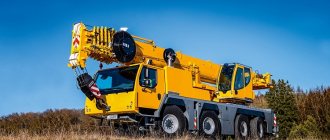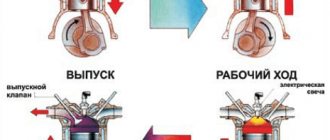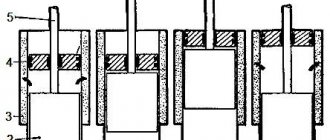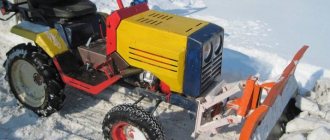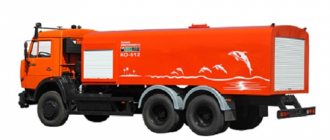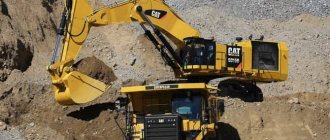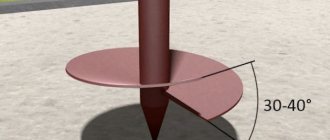Category: ENGINE
- Types of Subaru engines
- Description of models
- EX 17
- Engine Subaru EJ20
- EJ201
- EJ204
- EJ205
- EJ207
- Engine Subaru EJ25
- EJ251
- EJ253
- EJ255
- EJ257
- Engine FB20
- Motor EZ30
On Japanese-made Subaru cars, the manufacturer installs horizontally opposed power units. The Subaru engine has both advantages and disadvantages. During production, a large number of power plant models were produced.
Types of Subaru engines
The manufacturer labels the family of power plants with letter designations. By type of design, motors are divided into:
- Single cylinder. These include EX series power units, such as EX-17, EX21 Subaru-robin, etc.;
- Two-cylinder. These include models of the EK series, produced from 1960 to 1989 and having 2 working cylinders;
- Three-cylinder. From 1984 to 1993, the manufacturer produced engines with three working cylinders. Letter marking – EF;
- Four-cylinder. Since 1966, the manufacturer has been producing four-cylinder power plants. Models are marked with letters - EA, EE, EJ, EL, EN, FB, FA.
- Six-cylinder. Since 1987, the manufacturer has been producing engines with six working cylinders. Models are designated by letters - ER, EG, EZ.
INTERESTING: The EJ30 power unit belongs to the EJ series. This is a specialized series installation. Over the entire period, the manufacturer produced only 4 units of this model.
Description of models
Below is a description of some models of Japanese-made power plants provided for Subaru cars.
Subaru Robin EX21 engine The Subaru Robin EX21 engine is a single-cylinder power unit. It has four power strokes and is air cooled. EX21 starts well at any ambient temperature. Used for the manufacture of various equipment such as:
- Generators;
- Motor pumps;
- Cultivators;
- Walk-behind tractors;
- Mini tractors, etc.
The maximum power of the model is 7 horsepower. A modification of the device is EX21D. The manufacturer has modernized the launch system. This made it possible to reduce the effort exerted by the operator.
About the manufacturer
Nowadays, Subaru is better known as a manufacturer of vehicles, in particular cars. At the same time, the individual components that this brand produces at its factories are also considered high quality. This also applies to engines.
Subaru is a Japanese company with a hundred years of experience. Therefore, trust in it is not surprising, because for 100 years, Subaru products have shown themselves to be simply excellent. It is interesting that aircraft were initially designed and produced at the factories of this brand. Later, the company became closely involved in automobile transport, and then expanded its scope of activity, after which models of equipment for agriculture began to appear. Subaru's history also includes experience in the production of scooters. Their brand began to be produced in the second half of the forties of the last century.
One of the first leaders of the Subaru company was Kenji Kita. It was he who came up with the name for the company and helped the brand switch to the production of vehicles.
Agricultural machinery from Subaru began to appear relatively recently. But it immediately won respect from Russian farmers, because the devices are highly reliable and powerful. But the price of Subaru equipment is high. Therefore, some try to purchase only individual components, for example, high-quality motors.
EX 17
One of the EX series models. It has an overhead camshaft and a forced air cooling system.
The fuel required for work is gasoline. The motor has a cast iron working cylinder liner, which increases its service life. The maximum power of the power plant is 6 horsepower.
The Subaru EX17 engine is started manually or using an electric starter. The electric starter supply voltage is 12 volts. The basic configuration does not include a starter.
SOHC
- EJ20E. This engine was the first in the subseries under consideration. This is the most common naturally aspirated variant with single camshaft cylinder heads (SOHC). Available in several performance versions. The first develops 123 hp. With. and 172 Nm. It was installed on BC, BF Legacy for the domestic market and Isuzu Aska 1990 - 1993. On the second version, performance increased to 133 hp. With. and 181 Nm. It was equipped with JDM BD, BG Legacy and GC, GF Impreza, SF Forester. The most powerful was the third version, developing 153 hp. With. and 196 Nm, which was used at home for BE, BH Legacy and GC, GF Impreza. The latest modification, due to environmental standards, was derated to 138 hp. With. and 186 Nm. It was also used in the domestic market on BL, BP Legacy and GH - GE Impreza. European versions of the above-mentioned models in BC, BD, BF and GC, GF bodies had engines with a power of 113 hp. With. and 170 Nm.
In 1998, the EJ20 engines of the Phase II EJ201 and EJ202 series appeared. These open-block versions were equipped with lighter pistons, different cylinder heads and a lower manifold.
- EJ201. This engine develops 125 hp. With. and 184 Nm, installed on BE, BH Legacy and GD, GG Impreza.
- EJ202. This engine of the same performance was equipped with the JDM SF Forester. For the BL, BP Subaru Legacy, the EJ20 engine was modified by installing a lightweight block with lightweight liners, a redesigned intake manifold and a 4-2-1 exhaust. These improvements increased performance to 138 hp. With. and 187 Nm at the same speed.
- EJ203. This engine received a mass air flow sensor and an electronic throttle valve. Its performance is 138 hp. With. and 186 Nm. This engine was installed on the SG Forester and BP, BL Legacy for the domestic market.
- EJ20N. This is a version designed to run on natural gas.
Engine Subaru EJ20
The EJ20 engine is the base model of the family. The manufacturer has been upgrading the engine to this day. During production, a large number of modifications were released. Engine Subaru EJ20 characteristics:
- Number of working cycles – 4;
- Number of working cylinders – 4;
- The total volume of the working cylinders of the base model is 2 liters;
- The gas distribution mechanism drive is a belt drive;
- The arrangement of the cylinders is horizontal;
- The number of valves for each cylinder is two intake and exhaust;
- Cooling system EJ20 – liquid forced type;
- Coolant - antifreeze, antifreeze;
- Working cylinder diameter -9.2 cm;
- The piston stroke between dead centers is 7.5 cm;
- The power of the power plant depends on the year of manufacture - from 115 to 190 horsepower.
IMPORTANT: Above are the technical characteristics of the basic version of the motor. Depending on the modification, the characteristics differ.
Maintenance and operation
Factory regulations require changing the oil annually or after 10 thousand kilometers. It is recommended to reduce the interval to 6-7 thousand km, taking into account the design features of the engine and the age of the components. There are several types of oil pans on units; the volume is 4.0-4.5 liters.
The coolant has a shelf life of 2 years or 30 thousand km. At the same mileage, the air and fuel filters are changed. The life of spark plugs depends on engine power. Replacement is carried out after 20-40 thousand km.
The timing belt drive needs servicing every 100 thousand km. The belt and all rollers must be replaced. It is recommended to replace the pump, since the performance of the engine depends on the condition of the cooling system. During repairs, the gaps between the valves and cams are adjusted. The adjustment is carried out using a feeler gauge, the gap at the inlet is 0.20 mm, at the outlet - 0.25 mm. When replacing the valve covers, the rubber seals around the spark plug wells and screws must be replaced.
If timely maintenance is performed and original spare parts and oils are used, the service life of the naturally aspirated engine is up to 250 thousand km. Supercharged engine versions are less durable.
EJ204
Atmospheric power unit. The gas distribution mechanism includes 4 cam-type camshafts. To change the phases of distribution of air mass and exhaust gases, the AVCS system is used.
The engine was installed in the Subaru Impreza from 1993 to 1999. The maximum engine power is 155 horsepower. The engine has a forced cooling system. The coolant is antifreeze or antifreeze.
Technical features
The front suspension uses MacPherson struts, and the rear suspension uses an independent wishbone system. The crossover was offered with one of three transmissions: 4-speed automatic, 5- and 6-speed manual. It should be noted that modifications with a 4-speed automatic do not have permanent all-wheel drive. Here, instead of a central differential, a multi-plate clutch is used. Unfortunately, the Subaru Forester, like the fourth generation Subaru Legacy, did not take part in Euro NCAP crash tests.
EJ205
Turbocharged petrol power unit. Installed on models for both domestic and foreign markets. The engine is equipped with four camshafts. This design allows for improved engine performance with low fuel consumption.
Engine characteristics
- The volume of working cylinders is 1994 cm3;
- The maximum power of the power plant is 225 horsepower;
- Number of working cylinders – 4;
- Cylinder diameter – 9.2 cm;
- Number of valves per cylinder – 4;
- Fuel consumption – 12 l;
- Resource – 220,000 km.
ATTENTION: In case of improper maintenance or violation of operating rules, the service life of the power unit is reduced.
Oil intake
The EJ25 became famous for breaking off the oil intake tube, and it breaks at the very top. If the tube breaks off while driving, the engine will knock almost instantly. It happens that the tube breaks, then the low oil pressure indicator lights up, but goes out if you position the car on a forward slope, because In this case, the volume of oil flows forward and is sucked in, including through the crack.
So, this problem is real, unlike oil foaming. Tuning workshops for these Subaru engines offer reinforced oil intakes, which also maintain normal oil suction under strong lateral overloads, when the oil in the sump drains from the “umbrella”.
Why does the Subaru EJ25 lift the 4th connecting rod bearings?
So why does the EJ25 engine lift and turn the 4th connecting rod bearing? First, we note that trouble can also overtake the bearings of the 2nd and 3rd connecting rod, which receive oil through the channel in the right semi-block.
In fact, the problem is the insufficient quality of lubrication in this friction pair. Well, the reasons are banal: most of the knocked-on EJ25s had a low oil level in the sump. That is, there was oil starvation.
Let's add to the risk factors low quality oil, oil dilution and thinning of the oil film, as well as tight driving, i.e. acceleration from low speeds in 4th gear. Still, the connecting rod journals of boxer engines are narrower than those of in-line engines. Experts also call such a reason as “clumsy chip tuning,” but this mainly applies to turbo engines. An over-enriched air-fuel mixture leads to accelerated dilution of the oil with fuel.
Therefore, for those Subaris who do not spare money on oil service, the EJ25 works regularly for half a million km without major repairs.
Engine Subaru EJ25
Compared to the EJ20, the model has better performance. The engine capacity is 2.5 liters.
Characteristics:
- Type of power unit - four-stroke four-cylinder;
- The arrangement of the working cylinders is horizontal;
- The number of timing valves for each cylinder is 4;
- Maximum power – depends on modification -155 – 300 horsepower;
- Motor life – 250,000 km;
- Gasoline consumption – 10.5 liters per 100 km;
- Gas distribution mechanism – cam-type camshafts;
- Number of camshafts – 4;
- The gas distribution mechanism drive is a belt drive.
During production, the model was modified several times. Specifications vary depending on the version. The main differences between the modifications are different compression ratios and maximum power.
Malfunctions and repairs
Common engine defects are:
- A sudden warming up of the engine, accompanied by the appearance of gas bubbles in the expansion tank, indicates a burnt-out head gasket. Further operation of the vehicle is prohibited until parts are replaced.
- Knocks when the engine is running cold, coming from the most distant 4 cylinder. The defect occurs due to insufficient lubrication and local overheating. The repair consists of replacing worn rings; it may be necessary to bore the cylinder bore.
- Increased oil consumption, exceeding 1 liter per 1000 km. This is a symptom of stuck piston rings that need to be replaced.
- Involuntary increase in idle speed. Occurs due to a breakdown of the regulator or damage to the throttle unit drives. To determine the cause, it is necessary to carry out diagnostics and replace failed parts with new ones.
- Engine knock
- Replacing the timing belt and water pump
- Removing the valve spring and replacing the seal
- Knocking noise when starting cold
- Replacing the valve cover gasket
EJ253
Power plant made in Japan. The engine has a horizontal arrangement of working cylinders, the total volume of which is 2.5 liters.
Model characteristics:
- Maximum power – 173 horsepower;
- Average gasoline consumption – 9 liters;
- Unit weight – 120 kg;
- Compression -10;
- Working cylinder diameter – 9 9.5 -100;
- The piston stroke between dead centers is 7.9 cm;
- Motor resource – 250,000 km.
The model has been produced since 1999. In 2009, the manufacturer carried out modernization. The diameter of the working cylinders was increased, the weight of the exhaust manifold was reduced, an air flow sensor was installed, etc.
Notes[edit]
- Michael Knowling (2 April 2004). "2004 Epic Engine - Subaru Engines". AutoSpeed Magazine
. Retrieved June 30, 2009. - Brunswick, Robert; et al., eds. (March 14, 1974). "Automobile Review 74". 69
. Bern, Switzerland: Hallwag SA: 483. Quote journal requires |journal=(help) - “Summary of the 77th Geneva International Motor Show: FHI will present the engine “SUBARU BOXER TURBO DIESEL” (press release). Fuji Heavy Industries Ltd. February 8, 2007. Retrieved August 28, 2022.
- Wojdyla, Ben (2008-04-23). "New Subaru EE20 Boxer Turbo Diesel in detail". Jalopnik. Retrieved December 8, 2010.
- ↑ abcdefg Momota, Kenji (February 22, 2008). "FHI details world's first horizontally coupled diesel for passenger cars". TechOn
. Nikkei Business Publications. Retrieved August 28, 2022. - "Technology: Performance - Subaru Boxer Engine". Subaru Global. Retrieved August 28, 2022.
- ^ abc Harima, Kenji (September 2008). "Subaru Boxer Diesel: The First Horizontal Four-Cylinder Diesel Engine" (PDF). MTZ
. Vol. 69. pp. 38–45. Retrieved August 28, 2022. - ^ ab "Special Article 4: Subaru's Global Warming Mitigation Approaches and Product Development Efforts" (PDF). Fuji Heavy Industries Ltd. 2009. p. 17. Retrieved August 28, 2018.
- “Fuji Heavy Industries presents new Subaru vehicles at the 62nd Frankfurt Motor Show” (press release). Fuji Heavy Industries Ltd. August 9, 2007. Retrieved August 28, 2022.
- ↑
"78th Geneva International Motor Show Show Preview: World's First SUBARU BOXER Diesel Engine Debuts on Legacy/Outback" (press release). Fuji Heavy Industries Ltd. February 8, 2008. Retrieved August 28, 2022. - “Press Information on SUBARU BOXER DIESEL (Subaru Legacy / Outback 2.0D)” (PDF) (press release). Fuji Heavy Industries Ltd. March 7, 2008. Retrieved August 28, 2022.
- "EE20 Engine Information". Subaru Diesel Crew.
- “Fuji Heavy Industries will unveil the Subaru Forester and Impreza models with the Subaru Boxer diesel engine at the 2008 Paris Motor Show.” (Press release). Fuji Heavy Industries Ltd. September 5, 2008. Retrieved August 28, 2022.
- “Exhibition review of the 80th Geneva International Motor Show” (press release). Fuji Heavy Industries Ltd. February 5, 2010. Retrieved August 28, 2022.
- “Exhibition review of the 83rd Geneva International Motor Show” (press release). Fuji Heavy Industries Ltd. February 7, 2013. Retrieved August 28, 2022.
- “North American Subaru sales reached an all-time high in fiscal 2013, with record monthly sales in the U.S., Canada and Australia in March -” (press release). Fuji Heavy Industries Ltd. April 8, 2013. Retrieved August 28, 2022.
- "World premiere" SUBARU VIZIV CONCEPT "at the 2013 Geneva Motor Show" (Press release). Fuji Heavy Industries Ltd. March 5, 2013. Retrieved August 28, 2022.
- "Summary of the 85th Geneva International Motor Show" (press release). Fuji Heavy Industries Ltd. February 6, 2015. Retrieved August 28, 2022.
- O'Kane, Tony (15 September 2016). "Subaru diesels and six-cylinder engine on endangered list". WhatCar
. Retrieved August 28, 2022. - "Subaru to switch to idle diesel engine in 2022 amid global shift to electric vehicles". Japan Times
. Kyodo. September 7, 2022. Retrieved August 28, 2022. - ↑
Milne, Stuart (7 March 2022).
"The end of the road for the diesel Subarus". Autoexpress
. Retrieved August 28, 2022. - Subaru Technical Magazine, No. 34 published June 2007
- Subaru Technical Journal Issue No. 33 Published June 2006
- Mark Vaughn. "Subaru Reveals Production Version of BRZ". Autoweek.com. Archived from the original on 2011-12-03. Retrieved December 1, 2011.
- "FHI develops next generation Subaru Boxer engine" (PDF). Fuji Heavy Industries. September 23, 2010. Retrieved October 3, 2010.
- ^ab Colwell, K.C. (January 2011). "Exploring Subaru's New FB Flat-Four Series". Car and driver
. Hearst Corporation. Retrieved April 15, 2011. - ↑
Bremner, Richard (17 January 2011).
"Subaru Forester 2.0 XS Review". Autocar
. Haymarket Media Group. Retrieved April 15, 2011. - Stocksdale, Joel (20 August 2020). "Subaru Levorg, aka WRX wagon cousin, revealed in production form". Autoblog
. Retrieved September 2, 2022. - Lye, Gerard (21 August 2020). “2022 Subaru Levorg officially debuts in Japan - SGP platform; new 1.8-liter turbocharged boxer engine and EyeSight X." paultan.org
. Retrieved September 2, 2022. - "スペック" [Specifications]. Subaru from Japan
. Retrieved September 2, 2022. - “2009 Subaru Outback 3.0L 5AT Limited Engine Assembly. Cooling - 10100BR310 - Genuine Subaru part." parts.subaru.com
. - Reed, Matt. "Welcome to the Subaru Legacy mini-site". 3Keys Legacy
. Retrieved February 4, 2022.
EJ255
Reliable Japanese-made engine with an aluminum cylinder block. Engine capacity 2.5 l. The maximum power rating is 230 horsepower. The installation runs on AI-95 - 98 gasoline.
REFERENCE: A distinctive feature of the EJ255 is its low fuel consumption. The average is 8.5 liters.
The model is available in an atmospheric version, or with an installed turbine. Versions with turbines have four camshafts and a variable exhaust gas distribution phase system. Depending on the turbine, power ratings differ.
Tuning
The EJ251 powerplants are not equipped with a supercharging system, so the potential for increased power is small. It is practiced to install new firmware into the control controller. At the same time, the catalytic converters are removed, which ensures the free exit of exhaust gases. The power increase is up to 30-35 hp, while fuel consumption increases slightly.
There is information about isolated cases of the installation of turbochargers borrowed from other Subaru engines. To ensure engine performance, the compression ratio was reduced to 8.0-8.5 (by installing a modified piston group and connecting rods). The power of the unit increases by 100-120 hp. Due to the volume of modifications, the cost of the unit is high; it is more cost-effective to purchase and install a ready-made engine equipped with supercharging at the factory and install it on the car.
Engine FB20
Reliable power unit made in Japan. Distributed fuel injection. The model is controlled by an electronic unit. Characteristics:
- Type – petrol four-stroke;
- Cylinder block material – aluminum;
- Cylinder head material – aluminum;
- Number of combustion chambers – 4;
- Number of valves – 16;
- Number of camshafts – 4;
- The gas distribution mechanism drive is chain.
FB20 combined type lubrication system. The plain bearings of the FB25B crank mechanism are lubricated with oil under high pressure supplied from the oil pump.
Parts not subject to high loads are lubricated by spraying lubricant.
The manufacturer released the FB25 version. A distinctive feature from fb20 is the fuel supply system. The FB25 uses a multi-point sequential injection system. The diameter of the FB25 working cylinders has been increased to 94 mm. This made it possible to increase the power rating to 184 horsepower.
Motor EZ30
Six-cylinder power plant made in Japan. The total volume of the working cylinders is 3 liters. The engine has high power ratings - 250 hp. thanks to which it is installed on heavy Subaru cars. The model has a large resource. It is 300 thousand kilometers.
In 2003, the manufacturer upgraded the basic version, and based on it the EZ30D was released. The manufacturer installed new intake and exhaust manifolds made of plastic. The gas distribution mechanism drive is chain. The timing valves were equipped with a system for changing the phase distribution of air mass and exhaust gases.
From the above it follows that the manufacturer has produced a large number of power plant models designed for Subaru cars. Versions are available with different numbers of working cylinders. Released versions are systematically upgraded. This allows you to improve their technical characteristics. The power plants are distinguished by their build quality and unpretentiousness to operating conditions. The manufacturer produces single-cylinder engines used for installation in agricultural and industrial equipment.
Four cylinders[edit]
All four-cylinder Subaru engines (except EN series
) are liquid cooled, horizontal against four-punch boxer.
Subaru EA engine[edit]
EA was used from 1966 to 1994 on most models. This is a basic design with two valves per cylinder with siamese ports, or one port that is directly adjacent to another, and three crankshaft main bearings. Engines with overhead camshafts were installed with two timing belts, while cars with overhead valves used a timing belt exclusively.
Subaru EA82 Engine
- EA52: 977 cc OHV, 55 hp at 6000 rpm, used in the 1966–1971 Subaru 1000
- EA61: 1088.8 cc OHV, 62 bhp at 6400 rpm, used in the 1970–1972 Subaru FF-1 Star and Subaru G.
- EA62: 1267.5 cc OHV, 80 bhp at 6400 rpm, used in 1971–1972 Subaru G
- EA63: 1362 cc OHV, 58 hp at 5200 rpm, used in the 1973–1976 Subaru Leone.
- EA71: 1595 cc OHV, 67 hp at 5200 rpm or 68 at 4800 rpm, used in the 1976–1987 Subaru Leone. And Subaru BRAT/brumby 1978–1980.
- EA81: 1781 cc OHV, 73 bhp at 4800 rpm, used in 1980–1984 Subaru Leone and 1981–1993 Subaru BRAT/brumby
- EA81T: 1781 cc OHV Turbo, 95 hp at 4200 rpm, used in 1983–1984 in the Subaru Leone and Subaru BRAT/brumby.
- EA82: 1791 cc SOHC, 84-97 hp, used in Subaru Leone and Subaru XT
- EA82T: 1791 cc SOHC, 136 hp at 5200 rpm, used in Subaru Leone and Subaru XT
Subaru EE engine (diesel)[edit]
Subaru EE20 (2008)
Subaru unveiled the world's first boxer diesel engine to be installed in a passenger car at the 2007 Geneva Motor Show. [3] This 2.0 L DOHC engine, designated EE20, [4] has 110 kW (150 PS; 148 hp) at 3600 rpm and produces torque 350 N⋅m (260 lb⋅ft) at 1,800 rpm [5] [6] with a redline of 4,750 rpm. [7] The engine has a total displacement of 1,998 cc (122 cu in) with a 86 mm × 86 mm (3.4 in × 3.4 in) square bore per stroke with a compression ratio of 16.3:1 and uses five main bearings. EE20 shares bore pitch size and assembly line with EZ30 at Ooizumi factory; Compared to the modern petrol EJ20, which has the same displacement, the EE20 is 61.3 mm (2.41 in) shorter. [5]
The common rail injector solenoid is made by Denso and operates at 180 MPa (26,000 psi). [5] IHI geometry with variable turbo is mounted under the right side of the engine, next to the exhaust manifold, reducing turbo lag. [7][5] For the Legacy 2.0D, Subaru stated that fuel consumption improved by 15-20% (ranging from 5.6 to 6.4 L/100 km (42 and 37 mpg‑US)), and CO2 emissions fell from 196 to 148 g/km (0.70 to 0.53 lb/mi) compared to the equivalent petrol-engined model. [7] [8]
Fuji Heavy Industries (FHI) spent three years, starting in the fall of 2005, developing the EE20 after concluding that the brand needed a diesel engine to compete in Europe. [8] Details of the engine were first published in February 2008, [5] following an additional preview in Frankfurt in 2007, [9] and the official application announcement was made in Geneva in March 2008. [10] [ eleven]
The EE20 was originally released to meet Euro 4 emissions requirements; The oxidation catalyst and particulate filter are mounted close to the turbo, using heat from the exhaust gases, and the water-cooled exhaust gas recirculation system rules to meet. [5] Compliance was soon upgraded to Euro 5 [12] and Euro 6 in 2015.
Availability
As announced in March 2008 in Geneva, the EE20 was sold in Legacy (wagon and sedan) and Outback models for the European market; the diesel was at first offered only with a manual transmission, and the clutch and flywheel were specially modified for use with the diesel engine. [5] In September 2008, FHI announced that the EE20 would be available as a slightly modified variant (the diesel particulate filter was covered) for Forester and Impreza models sold in Europe starting in the autumn. For the Forester, power was reduced slightly to 108 kW (147 PS; 145 bhp). [13]
The EE20 was offered with the Impreza XV at that model's launch in 2010. [14] Subaru's continuously variable transmission (branded Lineartronic) was offered as an option on EE20-equipped Outback models beginning in 2013, [15] and also sold Lineartronic. The EE20 Outback will be launched in Australia later in 2013. [16] At Geneva 2013, the diesel Boxer was combined with three electric motors to form the Subaru VIZIV Concept's hybrid powertrain. [17] The Lineartronic EE20 transmission was added to the Forester in 2015. [18]
In 2016, citing increasingly stringent emissions standards, the Impreza project manager said further development of the EE20 had been stopped. [19] In September 2022, Subaru announced that diesel vehicle production would end by 2022; At the time, sales in Europe and Australia were around 15,000 diesel vehicles annually. The resulting capacity will be used to begin production of plug-in hybrids in 2018 and electric vehicles by 2022. [20] In Geneva in March 2018, Subaru UK confirmed its parent company's plans to cease diesel production, but it had sufficient supplies to meet these needs. projected demand until the end of 2022. [21]
Subaru EJ engine[edit]
The EJ engine was introduced in 1989 in the Subaru Legacy to replace the EA engines. It was designed from the ground up with five main crankshaft bearings and four valves per cylinder and can be either SOHC or DOHC and a single timing belt. The fifth digit is the only way to tell without seeing the engine.
Subaru EJ20G twin turbo
- EJ15: 1483.4 cu.m. See, SOHC, 1990–2003 JDM Subaru Impreza
- EJ16: 90 hp at 5600 rpm, used in the 1993–2006 Subaru Impreza.
- EJ18: 1820 cc SOHC, 110 hp at 5600 rpm, used in 1993–1996 Subaru Impreza, Euro and JDM Subaru Legacy.
- EJ20: 1994.3 cc CM, available in Australia, Europe and Japan, naturally aspirated, 115–190 hp. and turbocharged 220–280 hp used on most models (2002–2005 WRX in US)
- EJ22: 2212 cc See, 135–280 hp, used 1989–2001 in the Subaru Impreza and Subaru Legacy.
- EJ25: 2457 cc cm, 165–320 hp in most models from 1995 to present
- EJ30: Special limited engine. Four were built by Subaru, but only three remain operational. There is no technical information or information available about these engines.
The EJ series can be broadly divided into two versions: Phase I engines (1989–1998) and Phase II engines (1999–2010). Phase II engines featured new cylinder heads and crankshafts with a thrust bearing located on the #5 connecting rod bearing instead of #3. The designation also changed from Phase I to Phase II. All Phase I engines have an alphanumeric suffix after the standard EJXX designation, all Phase II engines have a numerical suffix after the EJXX designation. Example:
Phase I: EJ15E, EJ15J, EJ16E, EJ18E, EJ20D, EJ20E, EJ20G, EJ20H, EJ20J, EJ20R, EJ20K, EJ22E, EJ221, EJ25D
Phase II: EJ151, EJ161, EJ181, EJ201, EJ202, EJ203, EJ204, EJ205, EJ206, EJ207, EJ208, EJ222, EJ251, EJ252, EJ253, EJ254, EJ255, EJ257
- There is at least one exception to this rule - the EJ20F MY'07 engine. Most likely, F stands for bi-Fuel (engines prepared to run on LPG). This engine model has reinforced engine valves. This is unconfirmed information based only on user experience and observations.
Subaru EL/Boxer type 3 engine[edit]
Engine (Japanese: Subaru EL)
replaced the EJ15 and is used in the JDM Subaru Impreza 1.5R (GD, GG, GE, GH series) starting with the 2006 model year. It is based on the EJ engine and shares many components, such as the crankshaft from the EJ25. It has DOHC cylinder heads with AVCS variable valve timing system on the intake. [22] [23]
- Displacement: 1,498 cc
- bore x stroke: 77.7 x 79 mm
- compression ratio: 10.1
- maximum power: 110 hp (81 kW) at 6400 rpm
- maximum torque: 14.7 kgm (144 Nm) at 3200 rpm
- AVCS
Subaru EN engine[edit]
The Subaru EN inline-four engine was introduced in 1988 to replace the straight two-series EK engine, which was originally designed as an air-cooled engine and later modified as a water-cooled engine used in the 1969–1972 Subaru R-2. EN is used in all kei cars and kei trucks currently produced by Subaru.
Subaru FA engine[edit]
Subaru FA20F
(Japanese: Subaru FA Engine)
The FA was developed from the FB engine, however efforts to reduce weight while maintaining strength were the main goals of the FA engine. While the FA and FB engines share a common platform, the FA shares very little individual parts with the FB engine with a different block, head, connecting rods and pistons. [24]
- FA20D: 1998 cc DOHC, aka Toyota 4U-GSE; 2013+ Subaru BRZ / Toyota 86
- FA20F: 1998 cc DOHC, turbo, 2012+ JDM Subaru Legacy 2.0GT DIT and 2014+ Subaru Levorg; 2014+ USDM and JDM Subaru Forester XT; 2015+ USDM Subaru WRX
- FA24F: 2387 cc DOHC, turbo, 2019+ USDM Subaru Ascent, 2020+ Subaru Legacy and 2020+ Subaru Outback
Subaru FB engine[edit]
Subaru FB16F
The FB series (initially available as naturally aspirated 2.5 and 2.0 liter engines) is the first of a new generation of boxer engines after the EJ series. Subaru announced details of the FB engine on September 23, 2010. [25] By increasing the piston stroke and reducing the piston diameter, Subaru sought to reduce emissions and improve fuel economy by increasing and expanding torque output compared to the previous generation engine.
The FB has an all-new block and head with dual overhead cams with variable intake and exhaust valve timing (AVCS - Active Valve Control System) and a timing chain that replaces the timing belt. The move to chain-driven cams allows the valves to be positioned at a tighter angle to each other and narrows the bore from 99.5mm to 94mm. This results in less unburned fuel during cold starts, thereby reducing emissions. Subaru also uses asymmetrical connecting rods like the EZ36
.
The FB is only slightly heavier and has similar external dimensions compared to the EJ engine of similar displacement. In January 2011, Car and Driver
was told that direct injection would soon be added. [26] In 2019, direct injection was added to the FB engines used in the 2022 Crosstrek, 2022 Forester, and 2022 Legacy and Outback models.
Subaru claims a 28% reduction in friction losses, largely due to lighter pistons and connecting rods. [26] [27] The FB has 10% improved fuel economy with faster power delivery and a wider torque band.
- FB16E: 1597 cc DOHC, 2012+ EUDM Subaru Impreza XV 1.6i
- FB16F: 1599 cc DOHC, turbo, 2014+ Subaru Levorg
- FB20B: 1995 cc DOHC, 2011+ JDM Subaru Forester, 2012-2016 Subaru Impreza and 2012-2017 Subaru XV
- FB20D: 1995 cc DOHC, Subaru Impreza 2017+ and Subaru XV 2018+
- FB20X: 1995 cc DOHC, 2014–16 Subaru XV Hybrid
- FB20V: 1995 cc DOHC, 2019+ Subaru XV Hybrid
- FB25B: 2498 cc DOHC, 2011–18 North American Subaru Forester, 2013–2019 North American Subaru Legacy, and 2013–2019 North American Subaru Outback
- FB25D: 2498 cc DOHC, 2019+ Subaru Forester in North America, 2020+ Subaru Legacy in North America, 2020+ Subaru Outback in North America, and 2021+ Subaru XV in North America
Subaru CB engine[edit]
| This section needs expansion . |
Engine CB
was first introduced in 2022 with the second generation Levorg.
[28] [29] The first engine in the series was designated CB18
, a 1.8-litre DOHC 16-valve engine equipped with dual AVCS with petrol direct injection and a turbocharger. Bore and stroke are 80.6 mm × 88.0 mm (3.17 in × 3.46 in) respectively, and the compression ratio is 10.4:1. Rated power output is 130 kW (180 hp). ) at 5,200–5,600 rpm, and torque is 300 N⋅m (31 kg⋅m; 220 lb⋅ft) at 1,600–3,600 rpm. [thirty]
- CB18: 1795 cc DOHC, 2022 Subaru Levorg, 2022 Subaru Forester
